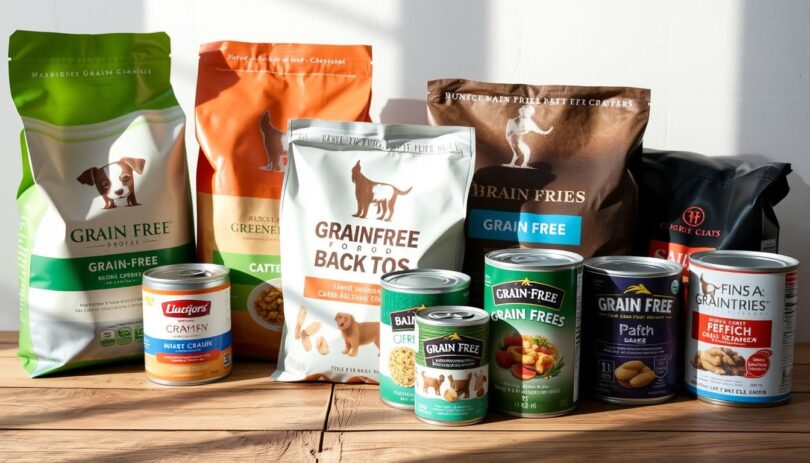Did you know only 1% of pets experience reactions to grains? Yet nearly a third of owners now choose grain-free meals for their furry companions. This gap between perception and reality highlights why pet nutrition deserves a closer look.
Human food trends often shape what fills our pets' bowls. As gluten-free and low-carb diets gained popularity, many assumed similar benefits applied to animals. But veterinary experts stress that canine needs differ dramatically from ours.
Small Door's medical team explains: “True grain sensitivities remain rare. Most pets thrive on balanced diets unless specific issues arise.” This guide cuts through the noise, offering science-backed insights for concerned owners.
We'll explore how to:
- Identify actual dietary triggers
- Evaluate nutritional pros and cons
- Make informed choices with veterinary guidance
Whether your companion has special needs or you're simply curious about food options, this resource prioritizes their well-being. Let's separate fact from fad using research, not trends.
Understanding the Rise of Grain-Free Diets in Dogs
Pet nutrition trends often start at the dinner table—yours. The mid-2000s saw pet food companies reformulate recipes as human gluten-free movements gained steam. This parallel shift created aisles filled with animal meals mirroring our plate choices, despite limited veterinary research supporting these changes.
The Human Trend Behind Grain-Free Choices
When celiac disease awareness spiked, 33% of Americans tried eliminating gluten. Pet brands quickly capitalized, promoting “ancestral” recipes with novel proteins and starch alternatives. This marketing pivot occurred as nutritional science evolved, though animal studies lagged behind human research.
| Trend Type | Human Adoption | Pet Food Impact | Scientific Support |
|---|---|---|---|
| Gluten-Free | High | Mass reformulation | Limited |
| Low-Carb | Moderate | Protein-focused recipes | Mixed |
| Grain-Free | Rising | 30% market share | Contested |
| Ancestral Diets | Niche | Wolf-diet claims | Debated |
How Owners Are Influenced by Dietary Fads
Marketing campaigns often frame grains as fillers rather than nutrient sources. This messaging taps into our desire for “natural” solutions, despite most companions thriving on balanced meals. The FDA's 2018 DCM warnings highlighted risks of following trends without veterinary input.
Nutritional shifts take time to validate. While some pets benefit from specialized plans, assumptions about universal advantages lack evidence. Always cross-check claims with your vet before altering meals.
Grain-Free Dog Food and Allergies: What You Need to Know
Common beliefs about pet nutrition often lack scientific backing, leading to widespread myths. Let's separate fact from fiction using veterinary research and clinical data.
Debunking Common Myths About Grain Sensitivities
Many assume grains trigger most dietary issues. Reality? Less than 1% of canines show actual sensitivities. Proteins like beef or chicken cause 80% of reactions, according to veterinary dermatologists.
Grains provide essential nutrients like B vitamins and fiber. Brands sometimes frame them as “fillers,” but quality whole grains support digestion and energy levels.
Scientific Evidence and Veterinary Insights
Peer-reviewed studies reveal three key findings:
| Claim | Research Findings | Veterinary Consensus |
|---|---|---|
| Grains cause allergies | False in 99% of cases | Rarely recommended for elimination |
| Grain-free prevents issues | No proven benefit | Only for diagnosed needs |
| Ancient grains better | Marketing term | Focus on balanced nutrition |
The FDA's DCM warnings highlight risks when diets exclude grains without medical cause. Always consult your vet before switching meals.
Realities Versus Marketing Claims
Packaging terms like “ancestral” or “natural” lack regulatory definitions. A 2023 analysis found 78% of grain-free products used emotional appeals rather than nutritional facts.
True medical needs differ from trend-driven choices. Specialized plans help specific cases, but most companions thrive on traditional formulas. Your vet can identify if changes truly benefit your furry friend.
Assessing the Nutritional Science and Potential Risks
Recent veterinary research reveals surprising connections between certain diets and heart health in pets. While meal choices aim to address sensitivities, some formulations might unintentionally impact vital organs.
Exploring the Link to Dilated Cardiomyopathy
Dilated cardiomyopathy (DCM) weakens heart muscles, reducing blood flow efficiency. The FDA’s 2018 investigation found higher DCM rates in pets eating meals rich in peas, lentils, or potatoes. These ingredients often replace grains in specialized recipes.
| Diet Type | Key Ingredients | Taurine Levels | Heart Risk |
|---|---|---|---|
| Traditional | Whole grains, animal proteins | Consistent | Standard |
| Alternative | Legumes, potatoes | Variable | Elevated |
Key Nutritional Considerations and Ingredients Analysis
Balanced meals require precise nutrient combinations. Studies show 91% of DCM cases involved diets lacking essential amino acids like taurine. While sensitivities exist, most companions thrive on formulas containing:
- Whole grains for B vitamins
- Animal-based proteins
- Fiber-rich carbohydrates
Always review ingredient lists with your vet. Look for AAFCO-compliant brands that prioritize proven nutrition over trendy claims. Heart health depends on science-backed choices, not marketing buzzwords.
Benefits of Grain-Free Diets for Dogs with True Allergies
While most companions thrive on traditional meals, a small percentage require tailored nutrition plans. For pets with confirmed grain sensitivities, carefully formulated recipes can offer meaningful improvements. Let’s explore how these specialized approaches work when properly prescribed.
Identifying When Specialized Nutrition Matters
Veterinary testing remains essential before making dietary changes. Blood work and elimination trials help pinpoint triggers, ensuring meals address actual needs rather than assumed issues. Three key benefits emerge for confirmed cases:
| Traditional Diets | Specialized Options | Key Differences |
|---|---|---|
| Contains whole grains | Uses alternative carbs | Reduces allergy symptoms |
| Standard fiber sources | Added prebiotics | Supports digestion |
| Common proteins | Novel protein sources | Minimizes reactions |
Fiber deserves special attention. Many grain-free recipes compensate with ingredients like pumpkin or sweet potatoes to maintain digestive health. Always check for added vitamins and minerals that replace those typically found in grains.
Professional advice proves critical during transitions. Nutritionists can recommend brands that balance allergy-friendly ingredients with complete nutrition. They’ll also monitor for potential gaps in essential nutrients over time.
Watch for signs like excessive scratching or recurrent ear infections. These may indicate sensitivities worth investigating. Remember—self-diagnosing often leads to unnecessary restrictions. Trust your vet’s expertise to guide these important decisions.
Practical Tips for Optimal Dog Nutrition
Navigating nutrition choices requires careful observation and expert guidance. By learning to spot subtle changes and partnering with professionals, owners can create meal plans that support vitality while avoiding unnecessary risks.
Recognizing Allergy Signs and Dietary Triggers
Persistent itching, recurrent ear infections, or digestive upset often signal dietary issues. These symptoms typically appear within 4-12 hours after eating. Common triggers include specific proteins like chicken or beef, though gluten occasionally plays a role in sensitive pets.
| Symptom | Recommended Action |
|---|---|
| Excessive scratching | Start elimination diet |
| Chronic diarrhea | Test for protein intolerances |
| Red skin patches | Consult veterinary dermatologist |
| Ear inflammation | Review ingredient sources |
Consulting Experts for Tailored Pet Nutrition
Veterinary nutritionists from organizations like Small Door emphasize three steps:
- Verify AAFCO compliance on labels
- Choose novel proteins if standard options cause reactions
- Track meals and symptoms in a journal
Portland Pet Food Company’s specialists note: “Failure to address nutritional gaps can worsen existing conditions.” Always source products from brands with board-certified experts on staff. Schedule follow-ups to assess your companion’s response to dietary changes.
Wrapping Up: Empowering Pet Health Decisions
Navigating your companion's nutritional needs requires balancing trends with trusted science. While specialized diets help address specific concerns, most pets flourish on balanced formulas containing diverse nutrients.
Key takeaways for owners: Prioritize veterinary guidance over marketing claims. Research shows skin vitality often improves with targeted nutrition, but only when changes align with medical needs. For feline companions, dietary requirements differ significantly—never assume cross-species solutions.
When selecting meals, focus on these essentials:
• Proven ingredients supporting heart health and digestion
• Brands meeting AAFCO standards
• Regular check-ins with your care team
Social media buzz and flashy packaging shouldn’t override professional input. If skin irritation or digestive issues persist, schedule a nutrition consultation. Your vet can pinpoint triggers while ensuring meals meet all biological requirements.
Every bowl choice shapes lifelong wellness. Pair quality ingredients with expert insights to build a thriving future for your four-legged family member.
FAQ
Can switching to grain-free formulas resolve itching or digestive issues?
While some pets show improvement, persistent symptoms often stem from other triggers like poultry, eggs, or environmental factors. Always consult a veterinarian for allergy testing before assuming grain elimination solves the problem.
What ingredients should I watch for in alternative diets?
Focus on high-quality protein sources (salmon, lamb) and digestible carbohydrates like sweet potatoes. Avoid fillers such as corn syrup or artificial preservatives. Check for AAFCO nutritional adequacy statements to ensure balanced meals.
How does dilated cardiomyopathy relate to boutique pet foods?
Research suggests certain grain-free recipes using legumes or potatoes as primary carbs might interfere with taurine absorption, a nutrient vital for heart health. Regular veterinary checkups help monitor cardiac function in pets on these diets.










Leave a Comment